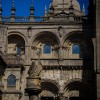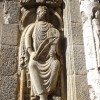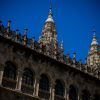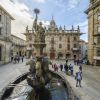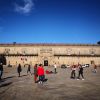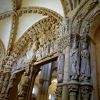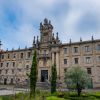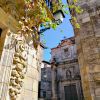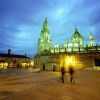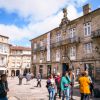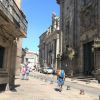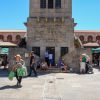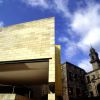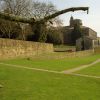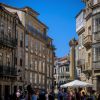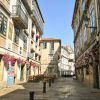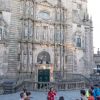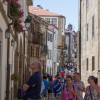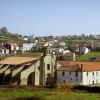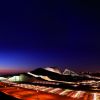- Accede I
- Regístrate I
- carrito
10. Plaza de las Platerías
10. Plaza de las Platerías
Galería de imágenes

Nos encontramos en la Plaza de las Platerías, que debe su nombre a los orfebres que desde la Edad Media se establecieron en los bajos asoportalados de la catedral, en los que aún hoy venden piezas de plata a los viajeros y peregrinos.
Fijemos la vista en la fachada sur. Esta es la única fachada románica que conserva la Catedral. Trazada originalmente a finales del siglo XI, fue severamente dañada debido a revueltas y altercados a lo largo de los siglos XII y XIV. Tras su gran deterioro fue reconstruida, por lo que muchas de las figuras fueron insertadas en desorden. Otras fueron traídas de la antigua fachada norte y de otros puntos de la catedral, formando el conjunto que hoy nos sorprende por su rica iconografía, dedicada a Cristo y a su doble naturaleza humana y divina.
En el friso conviven apóstoles, ángeles y signos zodiacales. En el centro se ve a Cristo bendiciendo. A un lado tiene a Santiago; al otro, seis pequeños ángeles traídos de la fachada norte ocupan un espacio vacío. A los pies de Cristo, la imagen cuadrada y más clara representa a Abraham emergiendo de la tumba. La pequeña figura cornuda debajo de éste es Moisés. En los portales, el tímpano de la izquierda parece representar la tentación de Cristo; y el de la derecha muestra escenas de la Pasión claramente reconocibles: el juicio de Pilatos, la flagelación y la traición de Judas. En las paredes laterales destaca, a nuestra izquierda, el rey David, sentado en su trono y tocando la fídula; sobre él, la creación de Adán, que tiene su espejo en el muro derecho, con la creación de Eva. Ambas escenas pertenecían a la llamada Puerta del Paraíso.
Si miramos a la derecha, justo al comenzar la torre, observamos unos arcos sin terminar, que seguramente formaban parte de un proyecto que pretendía cubrir la actual fachada románica.
A la izquierda, el claustro de la catedral nos muestra una adornada espalda, con escudos que representan escenas relacionadas con la tradición jacobea. Se distinguen perfectamente, en el extremo izquierdo, el Santiago guerrero a caballo; y en el derecho, la escena de la traslación de sus restos por mar hasta Galicia. Los dos discípulos llevan el féretro en barco, mientras un jinete los contempla desde las aguas. Esta imagen evoca una hermosa leyenda según la cual, al paso de la embarcación, un caballero que había caído al agua fue salvado por un milagro del Apóstol. Cuando salió del mar, él y su caballo estaban completamente cubiertos por conchas.
Mirando al conjunto de la plaza, nos llamará la atención, frente a nosotros, la imponente fachada de la Casa del Cabildo, decorada con motivos geométricos típicos del barroco compostelano, y algunas alusiones al tema jacobeo, como las estrellas y la concha. Fue concebida como un exuberante y fastuoso telón barroco, con el propósito de dotar de mayor espacio y belleza a este emblemático lugar, todo ello en detrimento de la propia funcionalidad interior, puesto que la profundidad del edificio apenas alcanza los 3 metros.
En el centro se alza la Fuente de los Caballos, del siglo XIX, en la que cuatro caballos escoltan a una mujer que, sentada sobre un sarcófago, levanta en lo alto una estrella. La suspicacia popular no sólo alcanza a decir que éste es el verdadero sepulcro del Apóstol Santiago, sino que ha inventado un ardid para los visitantes. No caiga usted en la tentación de acercarse a la fuente para ver a petición de algún compostelano los ‘atributos’ viriles de los caballos. Es sólo un truco para mojar a los incautos.









